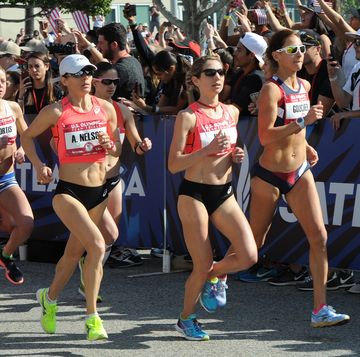You’ve probably seen ads for 5Ks at your local park or school. These races provide an accessible way to get started in racing, whether you want to run, walk, or do a combination of the two with the run/walk method. If you’ve considered signing up for one of these races, you may be wondering how many miles is a 5K?
At just 3.1 miles, a 5K offers an ideal choice for your first race. It requires relatively little buildup with training that doesn’t take over your life, and the race is over fairly quickly.
If you’re new to running and want to start training for a 5K, we advise getting a base of at least three to four runs a week—for at least two months—and averaging at least nine miles a week with a long run of three miles. Before you start a plan for your specific time goals, you should be able to run about 30 minutes without stopping.
If you are more of an intermediate or advanced runner, you may want to run your 3.1 miles faster and stronger than the last time you raced a 5K. To get better, incorporate different types of workouts beyond logging miles, such as hill repeats, speed workouts, or other faster-paced runs.
However you approach the 5K, there’s no doubt it’s one of the most accessible and fun distances to race. Keep reading for more on the basics of the 5K distance and the other popular racing distances you can line up for.
How many miles is a 5K?
A 5K is 3.1 miles. On a standard outdoor track, a 5K (5,000 meters) is 12.5 laps.
In 2023, there were more than 40,000 5K races in the U.S. listed on RunSignUp, with nearly six million people registering to race. That makes the race distance far and away the most popular distance in the country.
How many miles is a 10K?
A 10K is 6.2 miles, or 25 laps around a track.
Every year, tens of thousands of runners flock to popular spring and summer 10K events, such as the Crescent City Classic in New Orleans, the Bolder Boulder in Colorado, and the Peachtree Road Race in Atlanta (the largest 10K in America with more than 35,000 finishers).
The festive atmosphere and hoards of cheering fans draw runners in. And you can join the fun. We recommend at least eight weeks to prepare for race day, so you’ve got plenty of time to build up to completing 6.2 miles safely and comfortably.
How many miles is a half marathon?
The distance of a half marathon is 13.1 miles, or about 21.1 kilometers.
Many runners find the half marathon distance appealing: It requires training and endurance, but not nearly as much as a full marathon. However, it is far enough that you really need to train for it. Few people can finish a half marathon on a whim in the way that they might be able to run a 5K.
Running one or more half marathons is also a great stepping stone to preparing to run a marathon. Two of the biggest half marathons in the U.S. in 2023 were the Walt Disney World Half Marathon and the Philadelphia Half Marathon.
How many miles is a marathon?
A marathon is 26.2 miles, or 42.195 kilometers.
Running a marathon is not an easy task for many people, but with the proper training, finishing a marathon can be one of life’s most rewarding achievements. It’s generally recommended that runners train for 16 to 20 weeks before running a marathon.
Why is a marathon 26.2 miles?
The marathon distance has its roots in the story of Pheidippides, the Greek messenger who is said to have run some 25 miles, from Marathon to Athens, to deliver the news of a Greek battlefield victory. The first Olympic marathon was held in Athens in 1896; its distance was 40 kilometers, or just less than 25 miles. The current distance of 26 miles, 385 yards was first run at the 1908 Olympics.
How long is an ultramarathon?
Anything longer than 26.2 miles is considered an ultramarathon. The most common ultramarathon distances are 50K (31 miles), 50 miles, 100K (62 miles), and 100 miles. However, you’ll often see various other race and run formats in ultramarathons, such as 24 and 48 hour races, last runner standing, and fastest known times. Many ultramarathons are run on trails.
If you’re like one Runner’s World video editor, however, you may want to go even farther. Watch the video below as he documents the experience of running 200 miles.
What other race distances can you do?
Other race distances that are common but not as popular include the 8K (about 50 yards short of five miles), 15K (9.3 miles), and 10 miles. Additionally, four- and five-mile races are common, as well.
What is the distance around a track?
Standard running tracks are 400 meters, as measured by one lap in lane 1; that’s just a bit less than a quarter of a mile. One lap on a standard indoor track is 200 meters—exactly half of the distance of a standard outdoor track. Learn more about track events here if you are watching them on television, and if you’re looking for some general rules of the track, we have you covered as well.
Here are some other measurements that are helpful to know:
- 100 meters: the length of one straightaway
- 800 meters: roughly half a mile or 2 laps around the track
- 1600 meters: roughly 1 mile or 4 laps around the track (1609.34 meters is 1 mile)

Brian has spent more than a decade focused on creating compelling news, health, and fitness content—with a particular interest on enthusiast activities like running and cycling. He’s coordinated coverage of major events like the Boston Marathon, New York City Marathon, and Tour de France, with an eye toward both the professional race and the engaging stories readers love.













